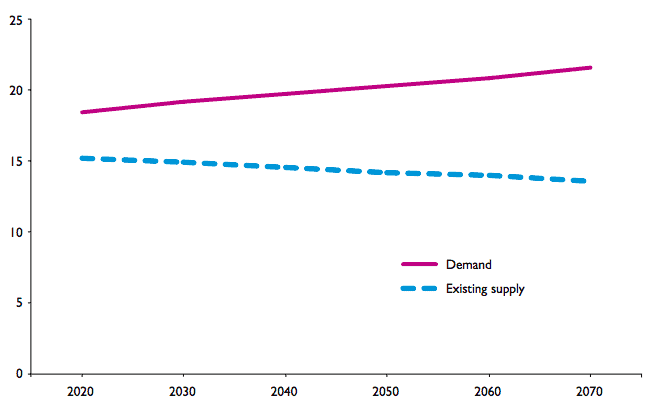The Bubba Wallace "noose" shows that we humans see the past and present as a Rorschach Test.
Water Everywhere...But
About one-third of all the water used in this country goes down the toilet. According to the experts who keep track of such data, each of us uses 1.6 gallons of water per toilet flush, and we do that an average of 2.13 times day. That adds up to about 102 gallons of water a month for each of us.
That means an office building of 100 workers flushes about 10,000 gallons each month. A school with 750 students, over 75,000 gallons. The Louisiana State Penitentiary, housing about 5,000 inmates, uses 6 million gallons of water every year — enough to fill more than 9 Olympic-sized swimming pools — for the sole purpose of flushing away their processed cafeteria food and iced tea.
Importantly, all this water is processed and treated the same as the water we drink. It’s coming from the same stressed aquifers and retaining ponds that are sucked dry come drought season. And it’s not just toilets. Water for washing cars and clothes, cooling manufacturing equipment, and for watering plants and crops and lawns is all put through the same energy-intensive process to bring it up to the standard we have for the water humans drink. Then we flush it right back to the facility it came from to be processed again.
That’s why in San Antonio, and increasingly across America, architects and engineers are looking to the sky for answers, by catching and processing rainwater that falls on the building to use for purposes other than human consumption.

Water supply and water demand are growing ever more apart in Texas, prompting the state to call for a quadrupling of water capture and recycling. Credit: 2017 State Water Plan, Texas Water Development BoardAll sorts of engineering projects are underway to catch rainwater for use and to separate drinking water from water used in less health sensitive areas.Our water sources are not infinite.
Groundwater is any water found underground in the cracks and pores in soil, sand, or rock. Groundwater provides 25% of the fresh water used in the United States. It is particularly important for irrigation and domestic uses in arid or remote areas, where surface water may be in short supply or far away. Groundwater is replenished when rainfall soaks into the ground, but it can take hundreds to thousands of years to replace what we extract. In arid areas, high demand for groundwater and slow replenishment provide challenges for sustainable groundwater management.
![Fresh groundwater and total fresh water withdrawals in the U.S. over time. For most of the 20th century, water use increased to support a larger population. Much of the recent decrease in water use is due to more efficient or reduced irrigation [2] Fresh groundwater and total fresh water withdrawals in the U.S. over time. For most of the 20th century, water use increased to support a larger population. Much of the recent decrease in water use is due to more efficient or reduced irrigation [2]](https://www.americangeosciences.org/sites/default/files/Water%20use%20over%20time.png)
Fresh groundwater and total fresh water withdrawals in the U.S. over time. For most of the 20th century, water use increased to support a larger population. Much of the recent decrease in water use is due to more efficient or reduced irrigation.
Some groundwater is used and then released to surface water bodies, such as rivers or lakes, but it is almost never pumped back into the ground. Instead, groundwater is replenished almost entirely by rainfall. In the United States, roughly one-quarter of all rainfall becomes groundwater. Groundwater makes up roughly 90% of the total available fresh water in the United States,1
The Ogallala Aquifer is the largest aquifer in the United States. It is part of the High Plains aquifer system, which underlies parts of eight states from Texas to South Dakota. 90% of the water extracted from the Ogallala Aquifer is used for irrigation, supplying the water for roughly one-third of all irrigated agriculture in the country.
Since the 1930s, massive water withdrawals have rapidly depleted the southern and central portions of the aquifer. In parts of Texas and Kansas, water levels have dropped by over 150 feet. The U.S. Geological Survey monitors the Ogallala Aquifer through its High Plains Water-Level Monitoring Study, reporting changes in water level and storage to Congress every two years. State geological surveys and other state agencies also monitor the aquifer.
Water withdrawals only tell part of the story. Many water uses involve the borrowing of water - for thermoelectric power generation, domestic and commercial use, mining, and industry - most of which is returned to water bodies after it has been used. Water consumption refers to the water that is withdrawn for human use but not returned. Irrigation accounts for around 80% of fresh water consumption: most is lost to evaporation and the incorporation of water into crops. Although groundwater provides 25% of the fresh water used in the United States, it provides 43% of the fresh water used for irrigation. As a result, groundwater accounts for around 40% of U.S. fresh water consumption.
(From McGraw, dan not don, and an AGI article) As you can imagine, this is an idea just begging for regulations and requirements, just like solar panels. It looks to be an early time to get into a neat little virtual signaling business with some serious income potential.
No comments:
Post a Comment